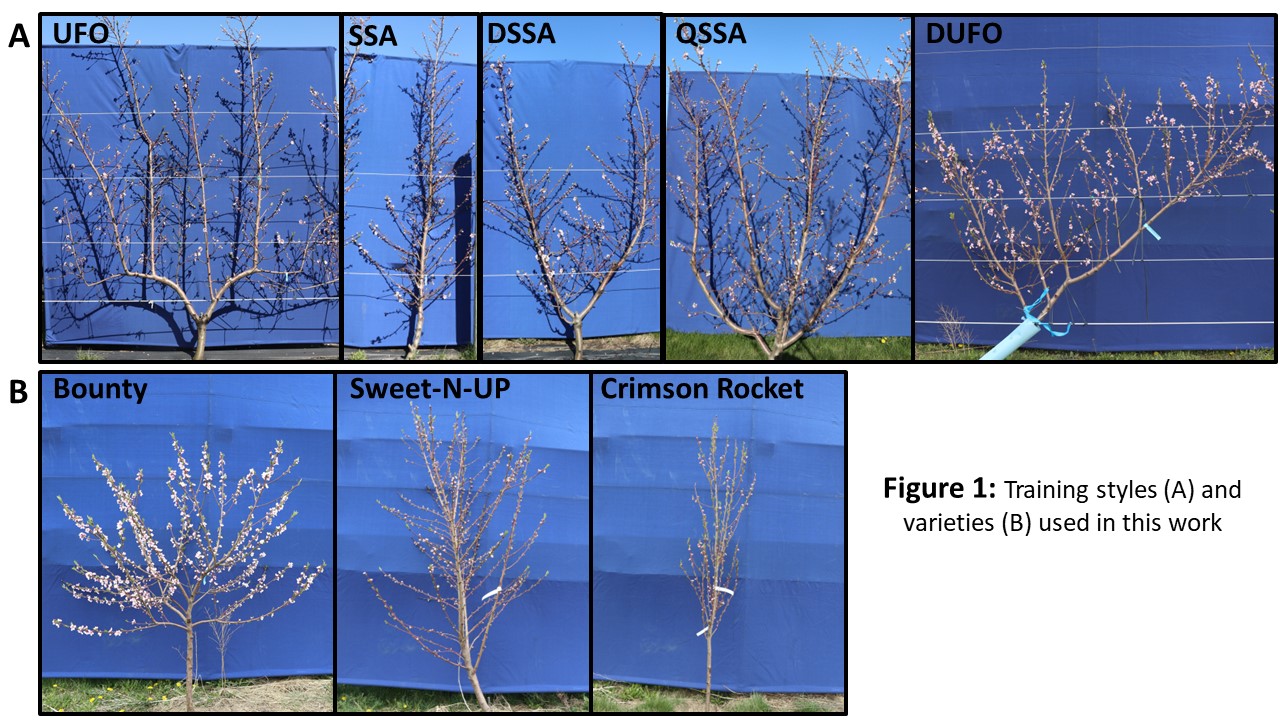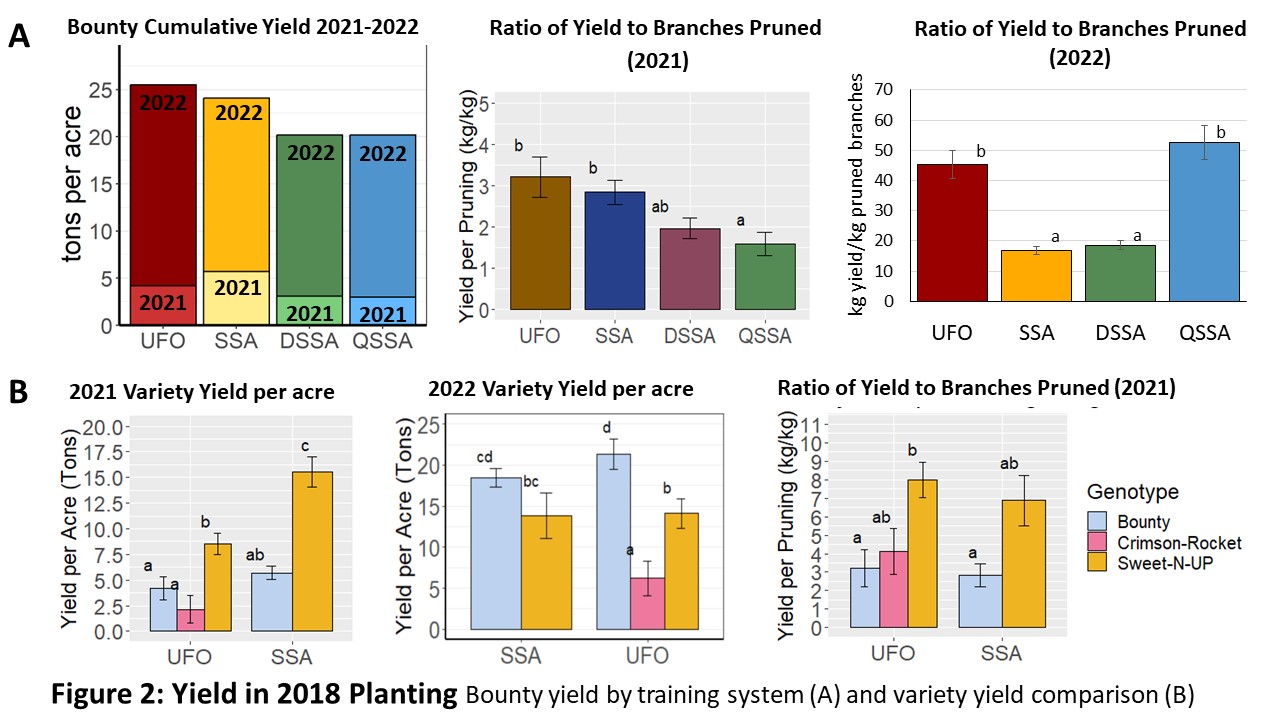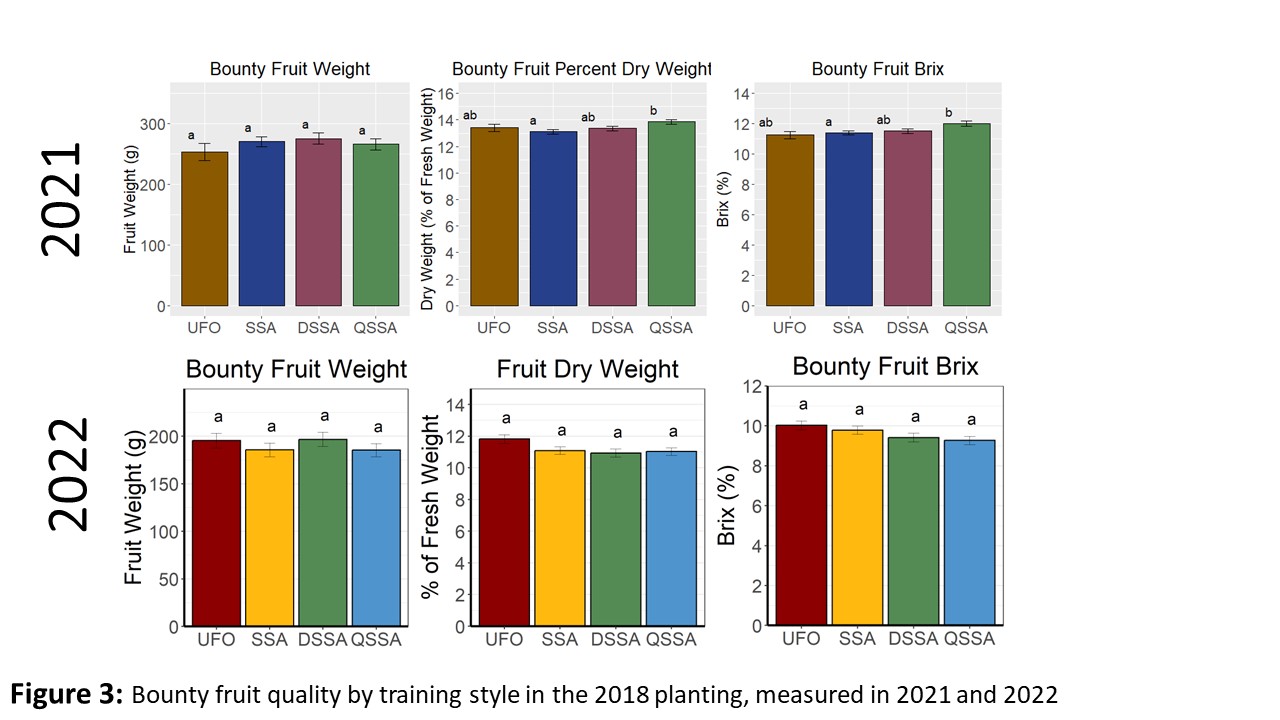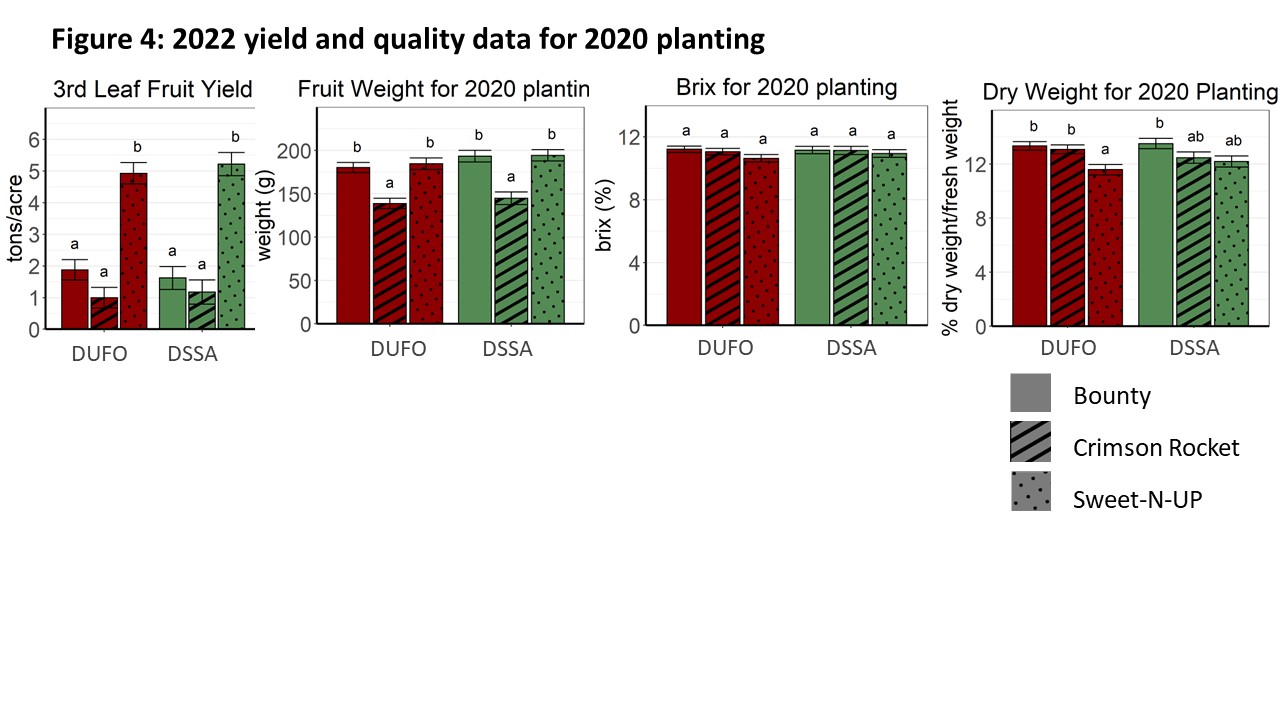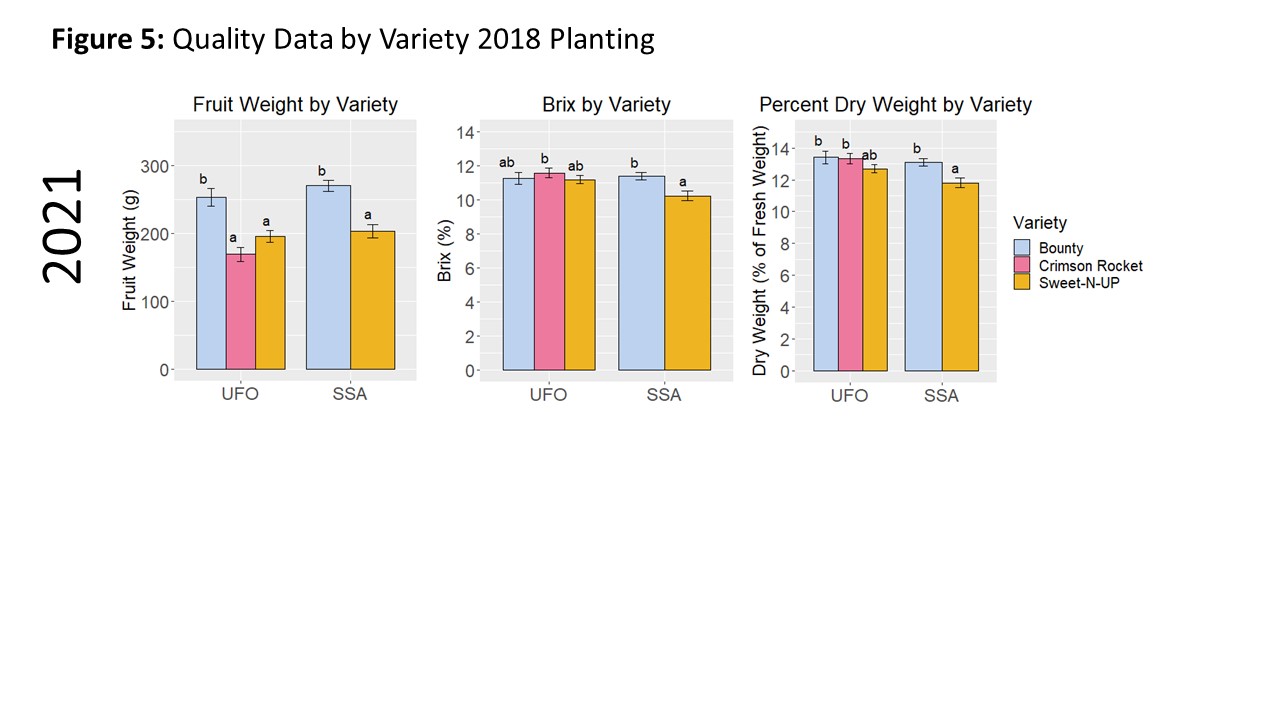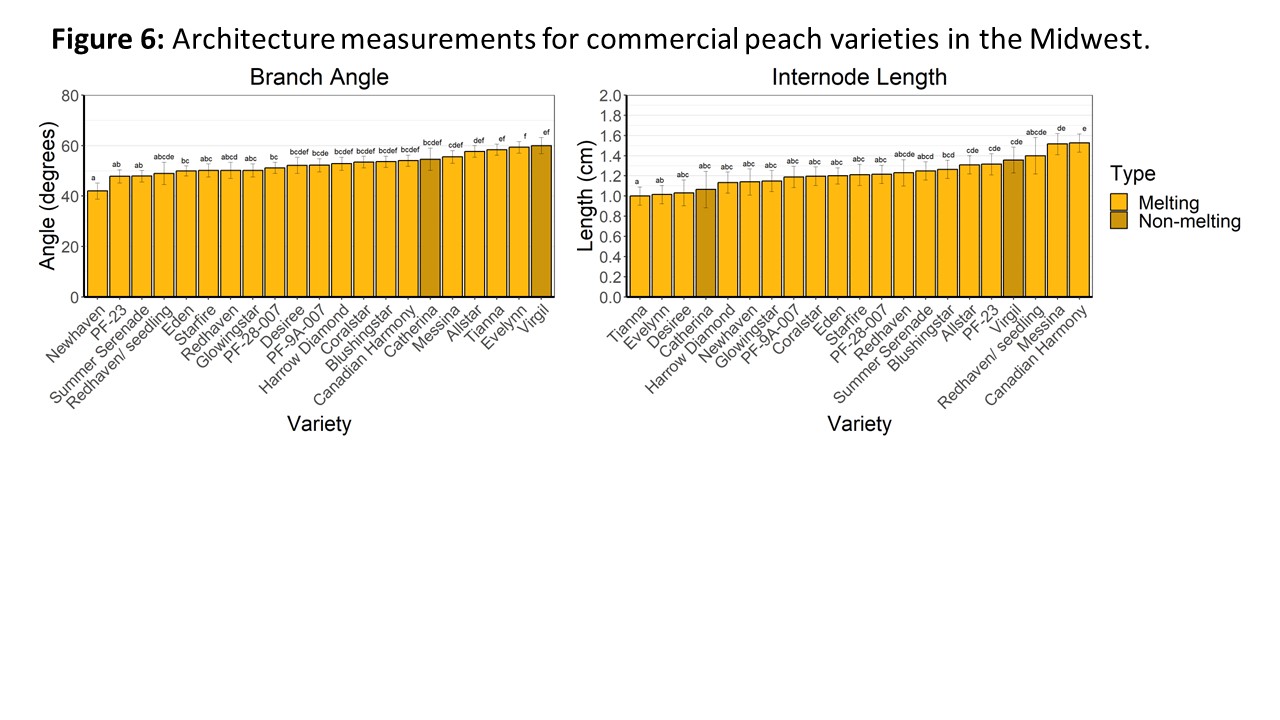Progress report for GNC21-327
Project Information
Improving sustainability of North Central Region peach production through novel training systems and optimization of branch angle.
Training tree fruits to high-density, planar canopy systems can increase sustainability by decreasing labor and pesticide inputs, while increasing fruit quality, yield per acre, and worker safety. High density systems using dwarfing rootstocks have been widely adopted by apple growers, however, their utility for peach (Prunus persica) is limited by high vegetative vigor due to the lack of dwarfing rootstocks, which makes training difficult and leads to high labor costs. This project advances development of high-density systems for peach by studying the optimization of tree branch angles for innovative training strategies. This unique approach will improve understanding of how these factors contribute to more efficient orchard systems, resulting in novel recommendations that can be applied by each grower to their particular situation.
To advance the adoption of high-density, planar production systems for peach, we have three objectives. First, we will explore how novel training systems affect tree vigor, canopy establishment, yield, and fruit quality. Utilizing two experimental plots, one in Clarksville MI and one in Benton Harbor MI, we will analyze how the number of leaders (vertically-oriented trunks) per tree affects these traits essential to growers. We hypothesize that increasing the number of leaders will reduce vigor without the need for dwarfing rootstocks, increasing the feasibility of high-density training systems. Second, we will look at how branch angle impacts training ease, light interception, fruit quality, and branch strength. We will examine three peach varieties with distinct genetically-determined branch angles. We hypothesize that narrower branch angles will facilitate planar canopy training. Third, we will survey growers to determine what they view as major obstacles to adopting high-density systems in peach. Further understanding these obstacles can guide future research and outreach to address those issues.
During the project, we will perform outreach through regional growers’ meetings and tours of our experimental plots. These will demonstrate our training techniques, helping growers make informed decisions. The efficacy of our outreach will be evaluated through post-meeting surveys. To reach a broader audience, our results will be published in journal articles and extension publications. We expect this research to increase the feasibility of high-density peach plantings in the Midwest, causing more growers to adopt these sustainable systems. This will increase growers’ production efficiency and enable more regional consumers to access and afford locally-produced peaches.
Through this project, we will investigate how high-density, planar peach orchards can contribute to sustainable fruit production, inform the fruit-growers of our results, and learn what the stakeholders consider to be major barriers to adoption of high-density systems. Our research lays the foundation for addressing these barriers by determining how several known issues—high labor costs, non-uniform fruit ripening, and high vegetative vigor of peaches—can be reduced by using novel training styles and optimized natural branch angles. Combining this knowledge with research on the branch angles currently available in commercial peach cultivars will provide general and specific recommendations to growers. These recommendations can help growers make informed decisions when selecting cultivars and training styles, and we believe this will lead to increased adoption of high-density systems for peach production in the North Central Region. This will improve the sustainability of peach production by simultaneously increasing the economic viability and decreasing environmental impact through more efficient land and pesticide use. Increasing production and lowering costs will also enable more consumers to access affordable, fresh, nutritious peaches from their local growers, enhancing community well-being and further supporting North Central Region agriculture.
Cooperators
- (Researcher)
- (Researcher)
Research
We used three different peach plantings for this project. In order to compare the effects of differing leader numbers and planting densities in novel planar training systems, we utilized a 2018 planting of Bounty peaches in Clarksville, MI trained into three planar systems —upright fruiting offshoots (UFO) at 8’ x 12’ spacing, super slender axe (SSA) at 3’ by 12’ spacing, and dual SSA (DSSA) at 6’ x 12’ spacing —and a three-dimensional system, quad SSA (QSSA) at 8’ x 12’ spacing (Figure 1). Thus far, data has been collected for two growing seasons, 2021 and 2022 (4th leaf and 5th leaf). To assess productivity and efficiency of each system, we measured yield per tree, estimated yield per acre, and calculated yield per excess vegetative growth, as measured by the fresh weight of pruned branches throughout the season. To evaluate the effects of each system on fruit quality and uniformity, we measured fruit weight, fruit firmness, percent blush, brix, and dry weight.
Second, in order to compare the effects of varieties with differing branch angle in different planar training systems, we utilized 2018 and 2020 plantings in Clarksville, MI of Bounty (spreading branch angle), Sweet N’ Up (upright branch angle) and Crimson Rocket (narrow branch angle). The 2018 planting was trained in at 8’ x 12’ spacing (all three varieties) or SSA at 3’ by 12’ spacing (Bounty and Sweet N’ Up only), and the 2020 planting was trained in DSSA in 6’ x 12’ spacing or Drapeau-UFO (DUFO) in 8’ x 12’ spacing (Figure 1). Data for the 2018 planting was collected in 2021 and 2022, and data for the 2020 planting was collected for the first harvest in 2022 (3rd leaf). To assess training ease, we measured fresh pruning weight throughout the season. We also performed the same yield and quality measurements as described for the training style comparison.
Third, in order to examine the variance in tree architecture available in commercial peach varieties, we utilized a variety trial at the Southwest Michigan Research and Extension Center (SWMRC) in Benton Harbor, MI. To develop a profile of the tree architecture, we measured branch angle and internode length and documented overall architecture characteristics and flower bud location.
Finally, to better understand the concerns and tradeoffs which influence growers’ decision-making process about training systems we developed a grower survey. The online survey consisted of twelve questions, including four demographic questions concerning grower age, grower location, acreage, and crops grown; two questions about their current methods of growing peaches; three questions about their experiences and views of planar systems in peach; and three questions about their experiences and view of high-density systems in peach.
For the comparison of training styles using Bounty, the fourth and fifth leaf cumulative yield per acre was higher for UFO and SSA than DSSA and QSSA (Figure 2). For DSSA (two leaders) and SSA (one leader), both of which had leaders spaced at 3’ in the row, having only a single leader per tree (SSA) improved yield per acre, as would be expected from the vigor diffusion of having multiple leaders. However, UFO (6-8 leaders), with one leader every 12-18”, had higher yields than DSSA (2 leaders, 3’ spacing per leader) and QSSA (4 leaders). These preliminary results suggest that increasing leader density may offset the affects of vigor diffusion on early yield which arise in multiple leader systems. This vigor diffusion also led to improved ratio of the weight of fruit yield to the weight of excess vegetative growth pruned off (yield per pruning weight, Figure 2). UFO In 2021, QSSA had slightly higher dry weight and brix than SSA, but was not significantly higher than UFO or DSSA (Figure 3). This difference was likely due to differences in crop load, as spring frosts led to a very light fruit set and made thinning evenly difficult. No differences were observed in fruit weight. No significant differences in fruit weight, brix, or dry weight were observed between the four training systems in 2022 (Figure 3).
For the comparison of Bounty, Crimson Rocket, and Sweet N’ Up, there were clear differences in yield among the varieties (Figure 2, Figure 4). For the 2018 planting fourth leaf (2021), there were clear differences in yield per acre between the varieties, with Sweet N’ Up performing the best, and Crimson Rocket performing the worst (Figure 2). Sweet N’ Up performed significantly better in SSA than UFO, but that difference was not observed in Bounty. For the fifth leaf (2022) all three varieties once again showed significant differences, but no difference between training styles was observed for Bounty or Sweet N’ Up (Figure 2). In the 2020 planting, there were clear differences in third-leaf yield per acre between the varieties, with Sweet N’ Up again performing the best, but those differences were not affected by training style (UFO vs. DSSA; Figure 4). Significant differences were also observed in fruit quality between the three varieties, for the 2018 planting in 4th leaf (Figure 5) and for the 2020 planting in 3rd leaf, but these were not affected by training style (Figure 4 and 5).
For the comparison of architectural traits, preliminary results suggest that there is moderate diversity in architecture among existing cultivars (Figure 6). Estimated branch angles for the 21 varieties measured ranged between 40˚ and 60˚, while measured average internode length ranged from approximately 1cm to about 1.5cm.
Educational & Outreach Activities
Participation Summary:
- Consultation: Discussion with grower about starting a planar peach planting on his farm.
- Fact Sheet: A description of the research project was included in a booklet for the 2022 Ridgefest Tour at the Michigan State University Clarksville Research Center
- Press: An article describing the research project and results written by the PI was included in the July 2023 issue of Good Fruit Grower Magazine
- Tours: The research planting was included in the 2023 "Ridgefest" tour for Michigan tree fruit growers
- Presentations: Research was presented on posters at the Great Lakes Fruit, Vegetable, and Farm Market Expo (for growers) in both December 2021 and 2023 (See attached poster presentations), as well as on a poster at the ISHS 10th international peach symposium in Naoussa, Greece in June 2022. An oral presentation was also given by the PI's advisor (Courtney Hollender) at the 2022 Great Lakes Fruit, Vegetable, and Farm Market Expo.
Project Outcomes
Our research identified that planar peach plantings using the three methods we trialed were successful. These training methods can increase production without decreasing quality. In addition peach trees with upright architectures may be beneficial in planar peach systems.
Information Products
- Fruit Quality and Yield in Planar Training Systems for Peach (Conference/Presentation Material)
- Effects of Planar Training Systems in Peach on Fruit Quality and Yield (Conference/Presentation Material)
